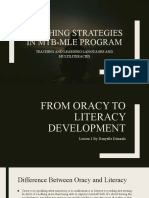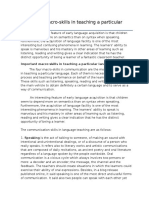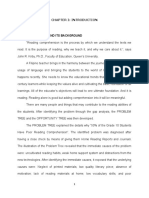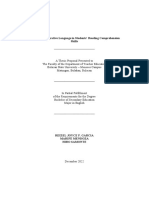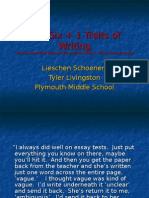Chapter 1
Chapter 1
Uploaded by
Reizel Joyce GarciaCopyright:
Available Formats
Chapter 1
Chapter 1
Uploaded by
Reizel Joyce GarciaOriginal Title
Copyright
Available Formats
Share this document
Did you find this document useful?
Is this content inappropriate?
Copyright:
Available Formats
Chapter 1
Chapter 1
Uploaded by
Reizel Joyce GarciaCopyright:
Available Formats
CHAPTER I
THE PROBLEM AND ITS BACKGROUND
INTRODUCTION
Reading is one of the macro skills that have an essential role in communication. We
have been taught about it in our childhood- from voicing out the sounds of each letter to
learning of associating them in pronouncing words. However, reading does not only focus on
articulating the words themselves but understanding their meanings too which actually is the
main purpose of it: for us to be capable of explaining what we just read. And as we all know,
communication is all about exchanging information, thoughts, or ideas which makes reading
became more significant in that aspect because we can go beyond the limit of conveying the
direct meaning of words, especially at the present time when people are starting to give
power to words than we usually do before. In that case, it obviously shows that it is indeed
our foundation in linking ourselves to the world where embracing literature as a means of
communication has been widely normalized.
In literature, interpretation is a vital instrument since we also employ our creativity in
making a literary piece, specifically in written text. One factor that could explain its
importance is the existence of figurative language. “A figure of speech is a non-literal way of
saying things: that is, the words have to be interpreted in order to understand the intended
meaning.” (Elder, 2004: 292). Consequently, it is typically seen to be used by many authors
in order to express their own artistic style which contributes a lot to stimulate the interest of
the readers. On the other hand, there are still disadvantages present in this course of action,
particularly in the position of younger readers like students.
Some of the problems they commonly experienced are confusion caused by the
characteristic of figurative language as it intends to have a double meaning of the words.
Most students are struggling with analyzing what they read because they usually focus on the
actual meaning of the words which they adapt as a practice as they are more exposed to
learning grammar wherein they are expected to follow a specific rule. Kathpalia & Carmel
(2011) states that “All over the world people are becoming students of English. Many of
these English programs follow a prescribed program that is focused on grammar and not on
conversational language.” As a researcher, this has become the primary reason why we feel
the need to address or discuss this issue.
This study aims to serve as an eye-opener for everyone about the significance of
understanding figurative language and also to promote awareness that this matter is
something that we should pay attention to and not disregard.
STATEMENT OF THE PROBLEM
The general problem of this study is to determine the Significance of Understanding
Figurative Language for Improving Students’ Reading Comprehension skills in Grade 10
students of San Francisco Xavier High School.
Specifically, it aims to answer the following problem:
1. How much is the prior knowledge of the students regarding figurative language?
2. Is figurative language contributing to the success of students in terms of reading
comprehension?
3. Does understanding figurative language affects improving students’ reading
comprehension skills?
4. How students with and without knowledge of figurative language do differ in
terms of interpreting a text?
You might also like
- The Levels of Reading Comprehension of The 21st Century LearnersDocument36 pagesThe Levels of Reading Comprehension of The 21st Century LearnersJanna Dublas50% (8)
- Teaching Strategies in Mtb-Mle Program: Teaching and Learning Languages and MultiliteraciesDocument45 pagesTeaching Strategies in Mtb-Mle Program: Teaching and Learning Languages and MultiliteraciesLydia Ela100% (7)
- Psycho Geometrics The Science of Understanding People... and The Art of Communicating With ThemDocument3 pagesPsycho Geometrics The Science of Understanding People... and The Art of Communicating With ThemSale DjoleNo ratings yet
- Chapter 1 - Review On Linguistic Components of LanguageDocument6 pagesChapter 1 - Review On Linguistic Components of LanguageMa. Cecilia BudionganNo ratings yet
- Authentic Reading ExperienceDocument5 pagesAuthentic Reading ExperienceNoor Suhada Bt MisromNo ratings yet
- 200 Tough Interview QuestionsDocument201 pages200 Tough Interview Questionsjockmystyle100% (1)
- ResearchDocument10 pagesResearchYukiko HachiNo ratings yet
- 037F WilsonDocument6 pages037F WilsonSyahira IsmailNo ratings yet
- Prososal JayDocument16 pagesPrososal JayJayanti Fitri ayuNo ratings yet
- Lesson1 LiteracyDocument6 pagesLesson1 LiteracyAlyssa EstreraNo ratings yet
- Judul Background ObjectiveDocument10 pagesJudul Background ObjectiveamhatmatozNo ratings yet
- The Importance of ReadingDocument18 pagesThe Importance of Readinglaura_mihaela233124No ratings yet
- Important Macro SKILLSDocument6 pagesImportant Macro SKILLSOllian300100% (4)
- Ela LiteracyDocument6 pagesEla Literacyapi-341213635No ratings yet
- Gst 101 Reading 2 by Tessa.Document34 pagesGst 101 Reading 2 by Tessa.josephereku03No ratings yet
- By Toby Fulwiler, On CurriculumDocument195 pagesBy Toby Fulwiler, On CurriculumJuan Luis Loza100% (1)
- Chapages BeriongDocument71 pagesChapages BeriongMaria Theresa CelebreNo ratings yet
- The Four Macro Skills in EnglishDocument7 pagesThe Four Macro Skills in EnglishKent Edgar YrayNo ratings yet
- Macro Skills and Reading PurposesDocument3 pagesMacro Skills and Reading Purposesgincky azuelaNo ratings yet
- From Oracy To Literacy Development of Young LearneDocument1 pageFrom Oracy To Literacy Development of Young Learnemoises vidalNo ratings yet
- KupsDocument21 pagesKupsSir G-ChNo ratings yet
- Comparative StudiesDocument66 pagesComparative StudiesJasmin CaballeroNo ratings yet
- Final Activity 1Document3 pagesFinal Activity 1Manayam CatherineNo ratings yet
- Seminar of LanguageDocument34 pagesSeminar of LanguageJulia RheintanataNo ratings yet
- Word Grouping Activities in IncreasingDocument24 pagesWord Grouping Activities in IncreasingBuana Letug100% (1)
- I.Title Proposed Title: Poor Understanding and Writing Academic TextsDocument13 pagesI.Title Proposed Title: Poor Understanding and Writing Academic TextsBea DeLuis de TomasNo ratings yet
- New Version 2Document3 pagesNew Version 2Isma Trucs PersonnaliséNo ratings yet
- DevRead Assignment Summary of ReadingsDocument10 pagesDevRead Assignment Summary of ReadingsLeriMarianoNo ratings yet
- Proposal ResearchDocument19 pagesProposal ResearchHady AdjahNo ratings yet
- 238-Article Text-422-1-10-20220220Document13 pages238-Article Text-422-1-10-20220220Sara alghurairNo ratings yet
- Teaching and Learning Literacy Reading and Writing Texts for a Purpose (David Wray) (Z-Library)Document224 pagesTeaching and Learning Literacy Reading and Writing Texts for a Purpose (David Wray) (Z-Library)Yaara NudlerNo ratings yet
- 06-06-2021 Reading and Writing Skills (Begla-138)Document92 pages06-06-2021 Reading and Writing Skills (Begla-138)rajniansh2022No ratings yet
- Teachers' Im'sDocument19 pagesTeachers' Im'sCMarie Cachero PazNo ratings yet
- Research TempoDocument40 pagesResearch TempoJs LantongNo ratings yet
- PROPOSALDocument9 pagesPROPOSALYanuari Cristy, M. Pd.100% (1)
- An Action Research ReportDocument28 pagesAn Action Research ReportMaryGraceBacalsoNo ratings yet
- Chapter IDocument17 pagesChapter IROSSANA DOCILBARNo ratings yet
- Assignment ON Classroom Reading: Submitted By, A.Akash, 19BDEN03Document6 pagesAssignment ON Classroom Reading: Submitted By, A.Akash, 19BDEN03AntoNo ratings yet
- Grammar in A Communicative Approach - William Littlewood ArticleDocument15 pagesGrammar in A Communicative Approach - William Littlewood ArticleAlysson Guariento100% (3)
- LITERACY ACROSS THE CURRICULUM-PRIMARYDocument47 pagesLITERACY ACROSS THE CURRICULUM-PRIMARYnaayirirNo ratings yet
- The Implementation of Reading Fluency Strategies in Primary SchoolersDocument19 pagesThe Implementation of Reading Fluency Strategies in Primary SchoolersErikaSotoNo ratings yet
- Unit 2 Task 3Document5 pagesUnit 2 Task 3luis fernando RinconNo ratings yet
- AdverbDocument7 pagesAdverbKent Edgar YrayNo ratings yet
- Jennifer Valencia Disciplinary Literacy PaperDocument8 pagesJennifer Valencia Disciplinary Literacy Paperapi-487420741No ratings yet
- Seminar On ELTDocument13 pagesSeminar On ELTWindi PutriNo ratings yet
- Lesson 4 - MTBDocument5 pagesLesson 4 - MTBFrezilla NoblesNo ratings yet
- Disciplinary Literacy Position PaperDocument5 pagesDisciplinary Literacy Position Paperapi-506655267No ratings yet
- Ch1 Exploring How Texts Work 2ndDocument8 pagesCh1 Exploring How Texts Work 2ndRusty LantacaNo ratings yet
- Analysis of Grammatical Errors in Writing I English Language Education Study ProgramDocument8 pagesAnalysis of Grammatical Errors in Writing I English Language Education Study ProgramAngelica De GuzmanNo ratings yet
- : A COMPARATIVE STUDY OF READING COMPREHENSION OF SELECTED SOPHOMORE STUDENTS IN POLYTECHNIC UNIVERSITY OF THE PHILIPPINES QUEZON CITY CAMPUS BETWEEN A.Y. 2011-2012 AND A.Y. 2012-2013 CORRELATES TO OTHER VARIABLESDocument66 pages: A COMPARATIVE STUDY OF READING COMPREHENSION OF SELECTED SOPHOMORE STUDENTS IN POLYTECHNIC UNIVERSITY OF THE PHILIPPINES QUEZON CITY CAMPUS BETWEEN A.Y. 2011-2012 AND A.Y. 2012-2013 CORRELATES TO OTHER VARIABLESJasmin Caballero98% (42)
- Reading AbilityDocument14 pagesReading AbilityDiane Quennie Tan MacanNo ratings yet
- Developmental ReadingDocument11 pagesDevelopmental ReadingSYLVIA R. DECOLONGON100% (1)
- Subject Assignment: Group: 2015-6Document10 pagesSubject Assignment: Group: 2015-6alex oviedoNo ratings yet
- Teaching Reading - Group 3Document12 pagesTeaching Reading - Group 3Fey'sNo ratings yet
- Referensi PentingDocument27 pagesReferensi PentingHannykha NissaNo ratings yet
- Chapter IiDocument21 pagesChapter IiLê Ngọc Quỳnh HươngNo ratings yet
- Saunders Content and Pedagogy Ela Literacy 3Document5 pagesSaunders Content and Pedagogy Ela Literacy 3api-614176439No ratings yet
- Ielp ModuleDocument51 pagesIelp ModuleJoseph Gerson BalanaNo ratings yet
- Reading ComprehensionDocument25 pagesReading ComprehensionPeter A Diaz100% (2)
- Lesson (Jonas)Document37 pagesLesson (Jonas)Ram Michael VillanuevaNo ratings yet
- Ddeguzman LiteracyfinalDocument8 pagesDdeguzman Literacyfinalapi-372938135No ratings yet
- The Early Literacy Handbook: Making sense of language and literacy with children birth to seven - a practical guide to the context approachFrom EverandThe Early Literacy Handbook: Making sense of language and literacy with children birth to seven - a practical guide to the context approachRating: 5 out of 5 stars5/5 (1)
- Final TGMDocument2 pagesFinal TGMReizel Joyce GarciaNo ratings yet
- Edited I IIIDocument33 pagesEdited I IIIReizel Joyce GarciaNo ratings yet
- Gender and SexualityDocument2 pagesGender and SexualityReizel Joyce GarciaNo ratings yet
- 1Document2 pages1Reizel Joyce GarciaNo ratings yet
- The Apa Citation Style: Lesson VDocument27 pagesThe Apa Citation Style: Lesson VReizel Joyce Garcia100% (1)
- RsatDocument6 pagesRsatReizel Joyce GarciaNo ratings yet
- The Reading Strategy Assessment Tool RsatDocument2 pagesThe Reading Strategy Assessment Tool RsatReizel Joyce GarciaNo ratings yet
- Reading PassageDocument1 pageReading PassageReizel Joyce GarciaNo ratings yet
- An Analysis of Accuracy Level of Google Translate (Fix Thesis)Document5 pagesAn Analysis of Accuracy Level of Google Translate (Fix Thesis)NisrinadifNo ratings yet
- Property Survey Sample Module MakingDocument14 pagesProperty Survey Sample Module MakingMichael Densing InsoNo ratings yet
- Eapp Module 17 18Document7 pagesEapp Module 17 18knit maudeNo ratings yet
- Bis Assignment 1Document12 pagesBis Assignment 1Rejoice Chikutye ChakawaNo ratings yet
- Arab Open University Tutor Marked Assignment (TMA)Document5 pagesArab Open University Tutor Marked Assignment (TMA)Elena AbdoNo ratings yet
- Discourse and Grammar (New)Document29 pagesDiscourse and Grammar (New)wafa TbeshatNo ratings yet
- Physical Education BrochureDocument41 pagesPhysical Education BrochureScribdTranslationsNo ratings yet
- Acadss PTDocument16 pagesAcadss PTMacadatar RaafatNo ratings yet
- Daily Lesson Log: Las Pinas East National High School Kasoy ST., Verdant Acres Subd., Pamplona III, Las Pinas CityDocument3 pagesDaily Lesson Log: Las Pinas East National High School Kasoy ST., Verdant Acres Subd., Pamplona III, Las Pinas CityJennyfer MayordoNo ratings yet
- Elements of CommunicationDocument3 pagesElements of CommunicationFrancine Alyssa GaliciaNo ratings yet
- CSIS Semester Planning - S1 2024-25Document6 pagesCSIS Semester Planning - S1 2024-25raghunathanNo ratings yet
- Adverbs and Its KindsDocument12 pagesAdverbs and Its KindsYounas Bhatti50% (2)
- Chapter 05Document19 pagesChapter 05zkNo ratings yet
- An Introduction To Syntax: by Anmol ArzooDocument12 pagesAn Introduction To Syntax: by Anmol ArzooKakar KakarNo ratings yet
- Data Analysis and Interpretation ENG 105Document28 pagesData Analysis and Interpretation ENG 105Ashik Ahmed KhanNo ratings yet
- Unnati - Vocab LessonDocument4 pagesUnnati - Vocab LessonunnatiNo ratings yet
- A2 A Empower Course OutlineDocument4 pagesA2 A Empower Course Outlineleakhena choemNo ratings yet
- Guidance ProgramDocument8 pagesGuidance ProgramJoerel AganonNo ratings yet
- MicrointeractionsDocument27 pagesMicrointeractionsPaco BenaventNo ratings yet
- Task 2 English ExerciseDocument5 pagesTask 2 English ExercisejohnyNo ratings yet
- The Six Traits of Writing Powerpoint For TrainingDocument26 pagesThe Six Traits of Writing Powerpoint For Trainingnstearns75% (4)
- Grammar Lesson Plan 26092018Document2 pagesGrammar Lesson Plan 26092018Zechrist Zechariah0% (1)
- Chapter2: Performance ManagementDocument29 pagesChapter2: Performance ManagementZulaikha ZafarNo ratings yet
- Jan 19 2024 Catch Up FridayDocument2 pagesJan 19 2024 Catch Up FridayDiana Rose Acupeado90% (10)
- Tesmc IpohDocument4 pagesTesmc IpohBernie VictorNo ratings yet
- Module 7 Learning StylesDocument38 pagesModule 7 Learning StylesFlorelene Hemongala BaludoNo ratings yet
- 當代中文 vs. 視聽華語主題及語法點對照 PDFDocument20 pages當代中文 vs. 視聽華語主題及語法點對照 PDFlunar89No ratings yet
- ENG001 Final Term Past Paper (Solved) - 1Document7 pagesENG001 Final Term Past Paper (Solved) - 1syedkhi92No ratings yet

